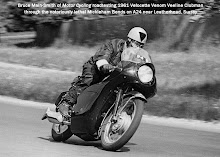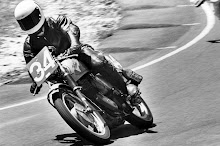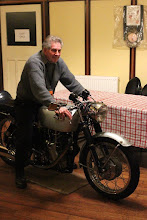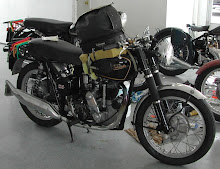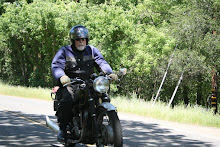Browsing through the motorcycle weeklies of 1936 prior to TT time we come across a comment that Velocette had some secret internal modifications to their race engines...In fact Velocette introduced a double overhead camshaft engine in their 350 racers for the first time and this pre-empted Norton.
See the comment from a weekly....
Left click on the images to enlarge....
Three engines were built for the 1936 TT. I'm unsure if they tried them in earlier races, but the factory records list them as having been built on 13th May 1936.
Engine numbers KTT483/S;KTT482/S and KTT481/s, with the riders being Stanley Woods, Ted Mellors and Ernie Thomas. Additionally Woods and Thomas' machines had the new rear spring frame. Mellors eschewed this for the tried and tested rigid one and interestingly used a block pattern front tyre on his machine....
Listed is a page from the factory KTT records and list special racing engines for 1936 and 1937.

The motorcycle weeklies were filled with sketches of the engines and the valve train...this from
The MotorCycle 28th May 1936.

Following are photos, courtesy of S.R.Keig Ltd., Circular Road, Douglas, IOM of these three machines with their riders.






The start is Ted Mellors pushing off...note the block front tyre....
Photo credit Fox Photos, London.
This shot is Ted Mellors rounding the Governors Bridge hairpin and the DOHC cambox is clearly visible.
Photo credit Fox Photos, London.
So after all the fanfare, what actually happened to them in the TT. The most publicised was the failure of Stanley Woods machine during the first lap with what was later reported as a sheared oldham coupling in the camshaft drive train. It was considered the additional load of the gear train etc contributed to it.
But the other two finished....

Looking at the ACU Stewards report of the race you will see that Ted Mellors came third and Ernie Thomas fourth. But a closer look reveals that Thomas crashed on lap 6 and was at that stage lying second, a minute and a half behind the winner Freddie Frith and over two minutes ahead of "crasher" White who eventually came second.
It is likely Thomas couldn't have won the race, but he probably would have finished second.
But as the old saying goes..."if your Aunt had balls she'd be your Uncle"....
Harold Willis the Velocette design and race chief was said to have gone off the DOHC idea after this...he seemed to be a rather superstitious man and reverted to the SOHC layout.
Norton of course took up the idea and made well out of it.
It seems that the DOHC was rarely used in the later European GP's of 1936, Mellors, who did the GP's in Europe for Velocette used the Mk.6 KTT prototype, Stanley Woods was contracted for the Irish races, the IOM TT and the Belgium GP. However a photo of Mellors in the Swedish GP appears to be on a DOHC machine, but this photo in the weeklies is poor quality and I could just be hoping it was the DOHC engine...
So what happened to these engines???Following the outbreak of WW2, Frank Mussett the Australian rider who appears to have struck up a good friendship with Percy Goodman, the Velocette managing director and designer, was given an engine and additional head/cambox which he took back to Melbourne, Australia.
During the war, Sid Willis, a well known lightweight rider was able to purchase a head/cambox from Mussett and used it on both his 250 and 350 racers to good effect.
Sid told me that on his favourite piece of road south of Sydney, used for testing, usually around dawn...the Heathcote Road, he gained another 1000revs over his SOHC setup on his 250.
Sid took this 250 DOHC to Europe in 1953 and finished 5th in the 250 IOM TT, the first privateer home.
Sid is pictured in the pits at the IOM in 1953. Photo credit again to S.R.Keig Ltd., Circular Road, Douglas, IOM.

The complete engine ended up also in Sydney in the hands of Ron Kessing, another successful Velocette racer who was in business with Don Bain in Enfield, Sydney as "Bain And Kessing" during the late 1940's.
Pictured outside their shop around 1948, is the DOHC 350 beside another ex factory 500 SOHC racer from 1934, it nicknamed "The Monster"...notice the "Loch Ness "monster seat... used on factory Velocettes before Velocette sold the patent for the dual seat to Feridax Ltd.

The following photo is of Sid Willis in the 1950's in Australia, not at Bathurst GP/TT races as he is carrying #30 and always rode #45 at Bathurst. The bike is a DOHC Velocette, but whether it is a 250 or 350 we can't be sure as Sid used the head on both. The date is 1954 or later as he is riding a Smith frame, a copy of the Beasley frame he bought from Doug St.Julian Beasley while in the UK in 1953 and crashed it badly at the last race, for him, of 1953, the hill climb in Freiburg, Germany. The frame was supposed to be repaired in Sydney by Stan "Nugge" Smith, who built a jig off it and built Sid a new frame, cutting up his original Beasley frame to investigate the tubing used, much to Sid's annoyance.

The third DOHC cambox was brought to Australia by Keith Campbell, the Melbourne based racer who won a world championship for Moto Guzzi and who tragically was killed racing. Keith brought a pile of factory Velocette parts back with him early in the 1950s and Gordon Harper a mate of Sid Willis and Jack Hogan rushed down and bought some of it, including a DOHC setup.
Jack Hogan used one on his 250 as a DOHC and won the 250 TT at Bathurst in 1955.
This cambox is in Western Australia and is featured in the photos following...
The engine is the ex Jack Hogan engine which won the 1955 250 TT at Bathurst, west of Sydney.


The cylinder head featured is a locally made one from special aluminium and cast by Sid Willis from a pattern made up by Ted Carey. Ted had made his own DOHC 250 setup on a MOV engine in 1948 and will feature in a later blog. These heads were nicknamed "Carey heads".
The original heads were initially used for the "Dog Kennel" engines, which were SOHC and the camboxex being easily removed, the DOHC version could be fitted to these heads.
One is featured below, ex Gordon Harper.

Finally a few parts from the DOHC setup... note the "pushers" between the cam and valve...they are made hollow and two piece to keep the unsprung weight down.
Ever inovative were Velocette.....





































































